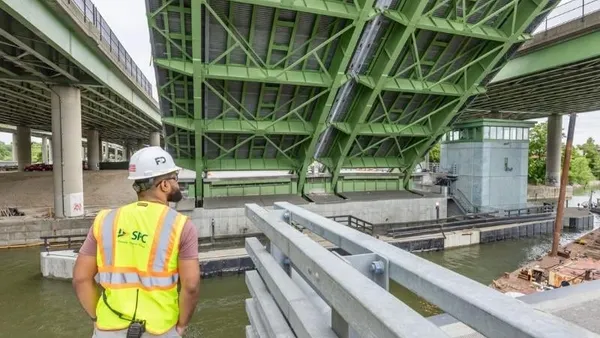Dive Brief:
- The Iowa Department of Transportation (IDOT) is investing up to $2 billion for an 18-mile stretch of state roadway near Council Bluffs, Iowa, the largest portion of which is a dual, three-mile divided highway that will help eventually separate and funnel traffic efficiently along an overlap of two major highways, according to Construction Equipment Guide.
- Although improvements will be made along the entire 18-mile Council Bluffs Interstate System Improvement Program area, the I-80/I-29 dual, divided highway, the first in Iowa, is expected to create safer, more organized traffic flow as it will allow motorists to use new local and express lanes to keep moving, even during lane closures for maintenance work and other events. Currently, many drivers weave through traffic trying to access exits, patterns to which some have attributed crashes and delays.
- Almost 90% of the project funding comes from the federal government and is one of the biggest projects in the IDOT's five-year Transportation Improvement Program.
Dive Insight:
Rather than simply adding more lanes to increase capacity, state transportation departments such as Iowa's, often use highway design to help traffic move more efficiently and safely.
Conventional highway designs include interchanges or ways of diverting traffic from one freeway to another or from the freeway to local roads. The most common are the cloverleaf, the diamond and the single-point urban or diamond interchange, but a hybrid of the diamond, the diverging diamond interchange (DDI), is growing in popularity. One of the DDI's most popular elements is the elimination of left-hand turns, which supposedly reduces the incidence of crashes.
The first DDI in the U.S. was constructed in Springfield, Missouri, and the Missouri Department of Transportation reported that in the first year of operation, there were 46% fewer crashes in that location and 72% fewer accidents related to left-hand turns.
The state of Florida has particularly taken to DDI highway systems, with 38 under construction or in development as of August 2017, according to Florida Today. At least six are included in the Ultimate I-4 project in the Orlando area.
One road design feature that has yet to take off in the U.S., however, is the roundabout. They're popular in Europe, and the Federal Highway Administration says the setup, which sees traffic flow in a circular motion around a fixed island, is safer because it eliminates left-hand turns in favor of right-hand ones, therefore eliminating more serious crashes. The potential for more efficient traffic flow with a roundabout is so attractive that state transportation departments are not the only authorities considering them. Officials for a new middle school in Easthampton, Massachusetts want to include one at the school's entrance in order to eliminate the long, projected wait to make a left turn.












